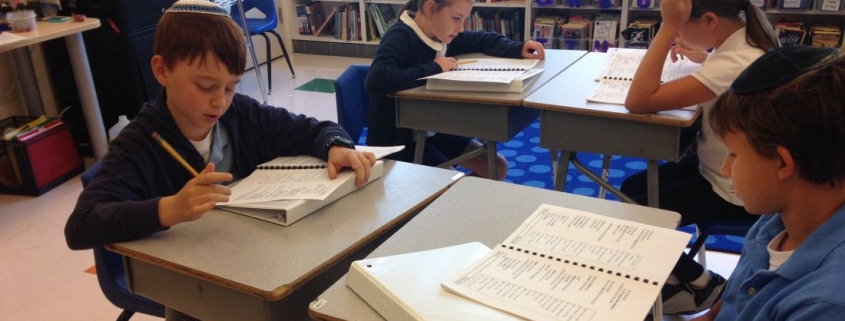30 Oct Rabbinics Standards and Benchmarks: Reaching for a Very High Bar
The room was filled with the hum of discussion and debate. In pairs and small groups my colleagues and I pushed ourselves and each other to think deeply about what is most important to us and our students. It was an inspiring moment to be a part of, and as I looked up from my group I was appreciative of the shared commitment to excellence that was represented by the activity all around me.
This week I spent three days participating in the inaugural conference of the Jewish Day School Standards and Benchmarks Rabbinics Initiative. Ruth Servi, our Middle School Coordinator and Jewish Studies teacher, and I joined teachers and school leaders from fifteen other Jewish day schools throughout North America and experts in the fields of Rabbinic literature and education. Together we are working to develop a compendium of standards and benchmarks for the teaching of Rabbinic literature in Jewish day schools. It is an audacious task for an enormous corpus of texts. We are trying to articulate the reasons that we study and value Rabbinic literature and the most important things within the field to teach our students. To make it even more complicated, the schools and participants in the project come from a variety of backgrounds and denominational affiliations across the Jewish spectrum, so it is not surprising that we do not all agree on why we study and teach these texts or what is most important within them. Despite the enormity of the challenge, I was impressed by how much agreement there was within the large group of educators and academics, and I was especially moved by the quality of our discourse. Everyone seemed eager to learn from one another and respectful of the variety of ideas that we brought to the table.
During the conference I found myself wondering what motivated the participants to join the project. Everyone there were accomplished and successful Jewish educators. The Jewish day schools were all invited to participate because the project leaders determined that those schools represent the knowledge in the field about teaching Rabbinic literature that would be needed in order to develop a meaningful set of standards and benchmarks. And the academic participants are experts in Rabbinic study and pedagogy. In other words, these people already know how to teach Rabbinic literature. What benefit is there for them to participate in a project aimed at advancing the theory and practice of the discipline they are already proficient in?
I believe the answer is a shared commitment to excellence. Everyone I met and worked with at the conference have many successes in their Rabbinics programs, and at the same time they all want to do even better. What Schechter Manhattan shares with the other schools participating in this project is a never ending aspiration to improve. Even as we can point to positive student outcomes from our curricular and instructional choices, we are always reflecting and asking ourselves: What could be even more impactful on students? What would lead to even more focused learning? What would make our teaching even clearer and more meaningful? This self reflection and desire to improve is why we accepted the invitation for Schechter Manhattan to join the Rabbinics standards and benchmarks project. We believe that we can learn from the process and we expect that as the standards and benchmarks develop we will see ways to adjust our Rabbinics curriculum.
In the coming months Ruthi and I will work with a Professional Development Working Group with teachers at Schechter Manhattan to consider how the Rabbinics standards and benchmarks will relate to our teaching at Schechter Manhattan and we will join together with colleagues from throughout the Jewish day school field for two more working conferences. Together we will reach for an ever rising bar of excellence.
Benjamin Mann
Author’s Chair
THIS WEEK WE ARE FEATURING WORK BY SOME OF OUR STUDENTS IN GAN, KITAH BET, KITAH DALET, AND KITAH CHET.
Gan did free writing about a topic of their choosing.
I GOt-A-POMKN I GOt GoURDS” (I got a pumpkin. I got gourds.)
Kitah Bet reflected on what it would be like to life in a world filled with “tohu va’vohu” (chaos).
I would feel Hapy because you kan jomp on the roots of a tree and flie.
I would feel uncumfterbel because evry thing would Be crase. And the ski would Be on the flor. and the houses would Be in the air.
I would feel wed (weird) because ef I wnt at (went out) I woud fol to the grand (ground).
Kitah Dalet brainstormed lists about things that they know a lot about. These lists will be developed into full paragraphs.
Things I know
- How to make Mac and chease
- to clean
- to do gymnastics
- work computers
- Gardens
- what teach aspect from you
- to get dressed
- to play soccer
- my morning routine
- focuse
- how to enjoy a day
–Elana A.
Things I know about
- How to braid
- How to chinese staircase
- How to open the door
- How to put beads on a braid
- How to write
- How to talk
- How to watch tv
- How to sing
- How to draw
–Jayla D.
Things I know about
- my family and friends
- History
- Math
- Writing
- books
- animals
- Magic
- Sports/gymnastics
- New York
- How to Swim
- me
- tv
- my morning routine
- Drawing
- atmosphere outerspace
–Shoshana B.
During Hebrew class Kitah Chet wrote about things that defined them.
הצבע שלי
מאת מאיר פרודה
.הצבע שלי ירוק. אני חושב שאנשים בעיר עושים הרבה רעש ואני לא אוהב את זה.
אבל אני אוהב את האנשים בעיר. אני אוהב טבע: יש רעש, אבל זה רעש טוב
–Micah P.



